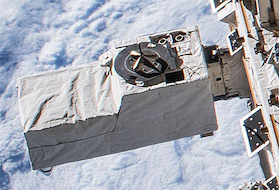|
|
CALET

The CALorimetric Electron Telescope (CALET)
is a Japan-led international mission funded by the Japanese Space Agency
(JAXA) in collaboration with the Italian Space Agency (ASI), NASA and
several universities in Japan, Italy, and the United States. The
instrument was launched on August 19, 2015 by a Japanese carrier,
H2 Transfer Vehicle (HTV), and robotically installed on the Japanese Experiment
Module-Exposed Facility (JEM-EF) on the International Space Station (ISS).
First events were recorded in October 2015.
Mission Characteristics
 Lifetime : October 2015 – present
Lifetime : October 2015 – present
 Energy Range : 7 keV – 1 TeV
Energy Range : 7 keV – 1 TeV
 Special Features : extremely high energy photon and cosmic ray particle detection
Special Features : extremely high energy photon and cosmic ray particle detection
 Payload :
Payload :
- The CALET Calorimeter (CCAL) measures the cosmic-ray total electron
spectrum from energy ~1 GeV up to Tev region. It’s components are:
- Charge Detector (CHD), a plastic scintillator hodoscope for
absolute charge measurement. It contains two orthogonal layers.
Each layer contains of 14 plastic scintillator paddles measuring
45 x 3.2 x 1 cm. It can detect charge between 1 and ∼40 Z
- IMaging Calorimeter (IMC), a sampling calorimeter. It consists of
16 kayers of scintillating fibers (SciFi) with 1 mm2
cross section, with alternating layers arranged orthogonally.
It also includes interspacing thin tungsten absorbers, and tracks
early show profile through the first 3 X0
- Total AbSorption Calorimeter (TASC), a thick lead tungstate (PWO)
hodoscope with 12 alternating layers of X-Y arranged logs, with
a total shower depth of 27 X0
- The CALET Gamma Ray Burst Monitor (CGBM) is sensitive from the
soft X ray (∼7 keV) to gamma ray (∼20 MeV) energy range.
- Hard X-ray Monitor (HXR; two identical units)
- 7 – 1000 keV
- Lanthanum bromide (LaBr3(Ce)) scintillation detector
- 61 mm diameter with 12.7 mm thick detector
- ∼ 3 sr field of view
- Soft Gamma-ray Monitor (SGM; one unit)
- 100 keV – 20 MeV
- Bismuth germanate (BGO) scintillation detector
- 102 mm diameter with 76 mm thick detector
- ∼ 8 sr field of view
In addition to the primary instruments, there are two other main
components. The Advance Stellar Compass (ASC) to determine the attitude
with arcseconds precision. The Mission Data Controller (MDC) capture and
format the data from the instruments, and sends the telemetry to the NASA
ground station.
 Science Highlights:
Science Highlights:
- High precision measurements of cosmic-ray electron and proton spectrum up to several
TeV
- Measurements and monitoring of galactic diffuse gamma rays
- Set limits on hard X-ray and gamma-ray emissions from gravitional wave event
GW151226
 Archive:
HEASARC hosts the space weather rates and the spectra from the CCAL instrument as well as the data from the CGBM instrument.
Archive:
HEASARC hosts the space weather rates and the spectra from the CCAL instrument as well as the data from the CGBM instrument.
[About CALET]
[Gallery]
[Publications]
[Archive (HEASARC)]
[CALET at DARTS (Japan)]
[All Missions]
[by Time]
[by Energy]
Page authors: Lorella Angelini Jesse Allen
HEASARC Home |
Observatories |
Archive |
Calibration |
Software |
Tools |
Students/Teachers/Public
Last modified: Wednesday, 28-May-2025 13:25:13 EDT
|


